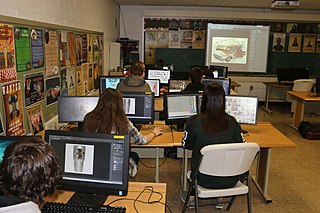High schools in North America are schools for secondary education, which may also involve intermediate education.
Highschooling in North America may refer to:

A college is an educational institution or a constituent part of one. A college may be a degree-awarding tertiary educational institution, a part of a collegiate or federal university, an institution offering vocational education, a further education institution, or a secondary school.
CCC may refer to:
Mayo often refers to:

A primary school, elementary school, or grade school is a school for primary education of children who are 4 to 10 years of age. Primary schooling follows preschool and precedes secondary schooling.

Tertiary education, also referred to as third-level, third-stage or post-secondary education, is the educational level following the completion of secondary education. The World Bank, for example, defines tertiary education as including universities as well as trade schools and colleges. Higher education is taken to include undergraduate and postgraduate education, while vocational education beyond secondary education is known as further education in the United Kingdom, or included under the category of continuing education in the United States.
Northern may refer to the following:
Three Rivers may refer to:
Senior means "the elder" in Latin and is often used as a suffix for the elder of two or more people in the same family with the same given name, usually a parent or grandparent. It may also refer to:
Carson may refer to:
NSS may refer to:
Challenger, Challengers, or The Challengers may refer to:
A junior college is a post-secondary educational institution offering vocational training designed to prepare students for either skilled trades and technical occupations and support roles in professions such as engineering, accountancy, business administration, nursing, medicine, architecture, and criminology, or for additional education at another college with more advanced academic material. Students typically attend junior colleges for one to three years.

A state school or public school is a primary or secondary school that educates all students without charge. Such schools are funded in whole or in part by taxation.

A secondary school or high school is an institution that provides secondary education and also usually includes the building where this takes place. Some secondary schools provide both lower secondary education and upper secondary education, i.e., both levels 2 and 3 of the ISCED scale, but these can also be provided in separate schools.

Twelfth grade is the twelfth year of formal or compulsory education. It is typically the final year of secondary school in most parts of the world. Students in twelfth grade are usually 17–18 years old. Some countries have a thirteenth grade, while other countries do not have a 12th grade/year at all.

The Ursulines, also known as the Order of Saint Ursula, is an enclosed religious order of women that in 1572 branched off from the Angelines, also known as the Company of Saint Ursula. The Ursulines trace their origins to the Angeline foundress Angela Merici and likewise place themselves under the patronage of Saint Ursula. While the Ursulines took up a monastic way of life under the Rule of Saint Augustine, the Angelines operate as a secular institute. The largest group within the Ursulines is the Ursulines of the Roman Union.
A bard is a minstrel in medieval Scottish, Irish, and Welsh societies; and later re-used by romantic writers.
TN status is a special non-immigrant classification of foreign nationals in the United States, which offers expedited work authorization to a citizen of Canada or a national of Mexico. It was created as a result of provisions of the North American Free Trade Agreement that mandated simplified entry and employment permission for certain professionals from each of the three NAFTA member states in the other member states. The provisions of NAFTA relevant to TN status were then carried over almost verbatim to the United States–Mexico–Canada Agreement that replaced NAFTA in 2020.

Maryland State Department of Education (MSDE) is a division of the state government of Maryland in the United States. The agency oversees public school districts, which are 24 local school systems—one for each of Maryland's 23 counties plus one for Baltimore City. Maryland has more than 1,400 public schools in 24 public school systems, with a 2019 enrollment of approximately 900,000. Of the student body, 42% are on FARMS and 22% are Title 1.
St. Pius X was a pope who was canonized.